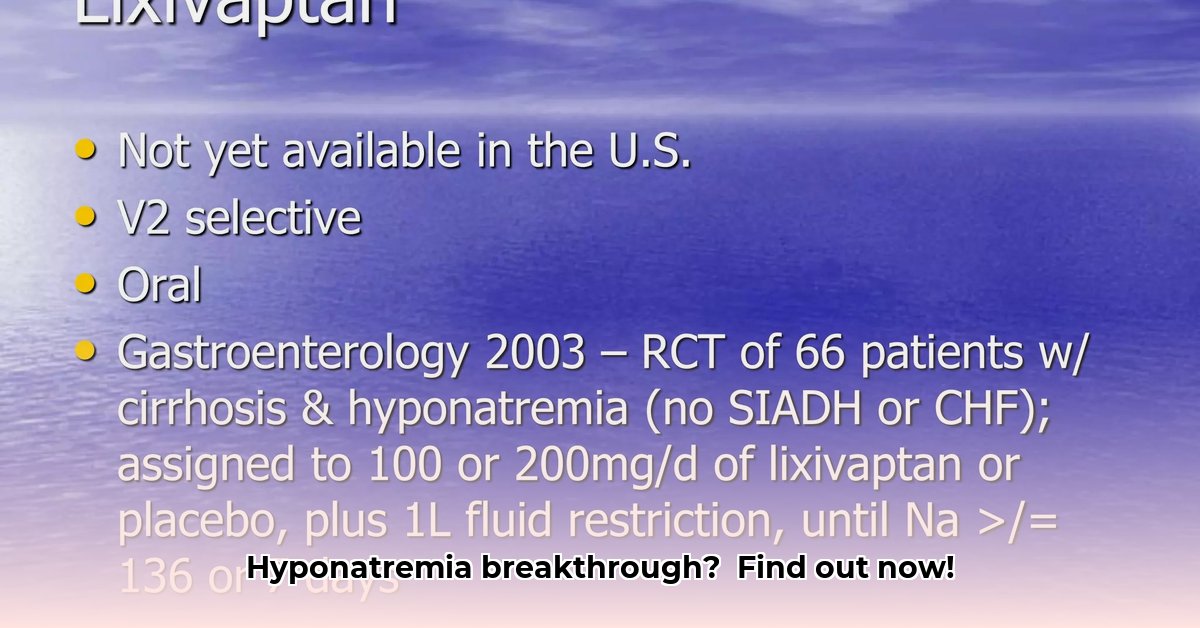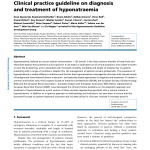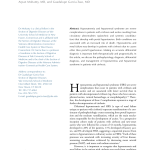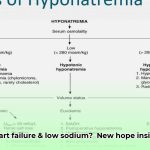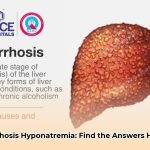Low blood sodium, or hyponatremia, can pose serious and potentially life-threatening health risks, affecting a significant portion of the population. Fortunately, advancements in treatment, specifically with vasopressin receptor antagonists (VRAs), offer a promising solution. This review delves into their mechanism, types, optimal usage, and considerations for clinicians prescribing these medications that are changing the landscape of hyponatremia therapy. For more detailed guidelines, see the hyponatremia treatment guidelines.
Vasopressin Receptor Antagonists: A Novel Approach to Correcting Sodium Imbalance
Hyponatremia, characterized by dangerously low sodium levels, presents pronounced risks, particularly for hospitalized patients. Current treatment strategies, such as fluid restriction, can be difficult for patients to adhere to and may not always be effective. This paves the way for VRAs to revolutionize the therapeutic approach. How can vasopressin receptor antagonists (VRAs) potentially change the game in treating hyponatremia? By directly addressing the underlying hormonal imbalance, VRAs offer a targeted and potentially more effective way to manage this condition.
How Do Vasopressin Receptor Antagonists Work to Increase Serum Sodium?
Vasopressin, also known as antidiuretic hormone (ADH), is a crucial hormone that regulates fluid levels in the body. It signals the kidneys to retain water. In some cases, its overactivity, often triggered by conditions like heart failure or SIADH (syndrome of inappropriate antidiuretic hormone secretion), leads to excessive water retention. VRAs counteract this process by selectively obstructing vasopressin’s action, specifically at the V2 receptor within the kidneys. This targeted blockage prompts the body to eliminate excess water without impacting sodium levels, a process known as aquaresis. Aquaresis is essential for the safe and effective correction of low sodium levels and distinguishes VRAs from traditional diuretics, which can deplete both water and sodium.
Classifying Vasopressin Receptor Antagonists: Tailoring Treatment to the Patient
Various VRAs exist, each possessing unique characteristics and receptor selectivity. Tolvaptan (Samsca, Jynarque), commonly administered orally, selectively blocks the V2 receptor and is used to increase sodium levels, particularly in euvolemic and hypervolemic hyponatremia. Conivaptan, on the other hand, blocks both V1A and V2 receptors and requires intravenous delivery, typically in a hospital setting for short-term use. Lixivaptan and Satavaptan are other VRAs under development or available in some regions. The choice of VRA depends on factors such as the type of hyponatremia, the severity of the condition, the patient’s overall health profile, and potential drug interactions. Physicians carefully evaluate these aspects to determine the most suitable VRA for each individual.
Vasopressin Antagonists: Balancing Benefits and Managing Side Effects
VRAs hold a distinct advantage by precisely targeting the underlying hormonal problem, mitigating the risk of disrupting other electrolyte balances. This selectivity contrasts with older treatments. However, VRAs can cause side effects. Increased thirst and nausea are common, as the body adjusts to the increased water excretion. Patients may also experience dry mouth, dizziness, fatigue, and increased urine frequency. More serious side effects, though rare, can include liver injury and overly rapid correction of hyponatremia, leading to osmotic demyelination syndrome (ODS). Vigilant monitoring by healthcare professionals is crucial. Ongoing research is essential for fully understanding the long-term implications of VRA therapy. More studies are needed to evaluate the long-term safety profile of VRAs, particularly regarding liver and kidney function, and to identify strategies for minimizing potential adverse effects.
Research Gaps: Optimizing the Use of Vasopressin Receptor Antagonists
While VRAs exhibit promise for treating acute hyponatremia, further research is necessary to evaluate their long-term efficacy in conditions like cirrhosis (scarring of the liver) and congestive heart failure. Scientists are actively identifying optimal VRA usage strategies to improve patient outcomes. Specific areas of investigation include:
- Long-term outcomes: Studies are investigating the long-term impact of VRAs on patient survival rates, overall disease severity, and quality of life in chronic conditions.
- Optimal dosing: Research is focused on identifying the ideal dosage regimens for different patient populations and disease severities to maximize efficacy and minimize side effects.
- Combination therapies: Scientists are exploring the potential benefits of combining VRAs with other treatments, such as diuretics or dietary modifications, to achieve synergistic effects.
- Biomarkers: The development of biomarkers that can predict VRA response and identify patients at higher risk of adverse events is an active area of research.
The Role of VRAs in Addressing Different Types of Hyponatremia
The underlying cause of hyponatremia must be considered when using VRAs, as the etiology greatly influences the treatment approach. The effectiveness of VRAs varies significantly depending on the cause of low sodium levels. Hyponatremia is often classified by volume status (euvolemic, hypervolemic, hypovolemic). VRAs are generally not appropriate for hypovolemic hyponatremia, where the primary problem is sodium and fluid depletion. In euvolemic and hypervolemic hyponatremia, VRAs can be effective in promoting water excretion and raising serum sodium levels. Therefore, accurate diagnosis is critical for selecting the appropriate VRA for each patient. Ongoing research seeks to refine our understanding of VRA applications across various hyponatremia subtypes.
Actionable Protocols for Healthcare Professionals
To effectively utilize VRAs, healthcare providers should adhere to the following key guidelines:
- Accurate Diagnosis: Confirm the specific type of hyponatremia (euvolemic, hypervolemic, hypovolemic) and its underlying cause (SIADH, heart failure, cirrhosis, etc.) before initiating VRA therapy. Correct diagnosis ensures appropriate treatment. Specific diagnostic tests include serum and urine sodium and osmolality measurements, as well as assessment of the patient’s clinical volume status.
- Fluid Balance Assessment: Scrutinize fluid intake and output to ensure therapeutic efficacy and safety. Continuous monitoring using tools like daily weights and accurate intake/output records ensures optimal fluid management.
- Close Monitoring: Monitor for adverse effects, such as overly rapid sodium correction, liver injury, and dehydration. Adjust treatment accordingly. Proactive management of side effects is essential, including patient education about potential symptoms and strategies for managing them. Serum sodium levels should be checked frequently, especially during the initial phase of treatment.
-
Collaboration: Stay informed about the latest research and guidelines to optimize patient care. Active engagement in clinical trials and knowledge sharing is essential for continuous improvement. Consult with nephrologists and other specialists as needed to manage complex cases.
Given the importance of an accurate diagnosis, what specific diagnostic tests are most crucial for determining the type of hyponatremia before initiating VRA treatment? Serum and urine osmolality, electrolytes, and a thorough assessment of the patient’s clinical volume status are essential.
The Future of Vasopressin Receptor Antagonists: Innovations in Research and Development
The pharmaceutical industry is actively engaged in developing novel VRAs with enhanced efficacy and reduced side effects. These advancements are expected to yield personalized and effective treatment options. Future directions include:
- More selective VRAs: Development of VRAs with greater selectivity for specific vasopressin receptor subtypes to minimize off-target effects.
- Novel delivery methods: Exploration of alternative delivery methods, such as subcutaneous injections or transdermal patches, to improve patient convenience and adherence.
- Personalized medicine approaches: Development of personalized VRA treatment strategies based on individual patient characteristics, such as genetic factors and disease biomarkers.
Combination therapies may also emerge, leveraging VRAs alongside other treatment modalities.
Regulatory Oversight: Ensuring Patient Safety
Regulatory bodies, such as the FDA in the United States and the EMA in Europe, are crucial in maintaining the safety and effectiveness of VRAs. Continuous monitoring of post-market surveillance data and periodic updates to treatment guidelines are standard practice. Funding ongoing research is essential to address existing knowledge gaps. This rigorous evaluation process is essential for safeguarding patient health and maximizing treatment success.
Patient Communication: Empowering Informed Decisions
Patients must be empowered to actively participate in their healthcare. Open communication with physicians is paramount, addressing concerns, side effects, and changes in condition. Participation in clinical trials can contribute valuable data to improve treatment strategies. Enhanced information sharing leads to enhanced hyponatremia management. Patients should be educated about the importance of adhering to their prescribed treatment regimen and reporting any new or worsening symptoms to their healthcare provider.
Summary of Available Vasopressin Receptor Antagonists
| VRA | Administration Method | Primary Use | Important Considerations |
|---|---|---|---|
| Tolvaptan | Oral | Euvolemic and hypervolemic hyponatremia (SIADH, heart failure, cirrhosis) | Monitor liver function, thirst, and nausea. Risk of overly rapid sodium correction. |
| Conivaptan | Intravenous | Euvolemic and hypervolemic hyponatremia, short-term use | Careful attention to fluid balance, potential low blood pressure. Monitor for injection site reactions. |
| Lixivaptan | Oral (Not widely available) | Euvolemic and hypervolemic hyponatremia, short-term use | Careful attention to fluid balance, potential low blood pressure. Limited global availability |
| Satavaptan | Oral (Not widely available) | Euvolemic and hypervolemic hyponatremia, short-term use | Monitor liver function, potential low blood pressure. |
- Wellness Fair Ideas for Work to Boost Employee Wellbeing - December 15, 2025
- Affordable Employee Wellness Fair Ideas for Any Budget - December 14, 2025
- Employee Wellness Programs Strategically Benefit Employee Health And Retention - December 13, 2025
